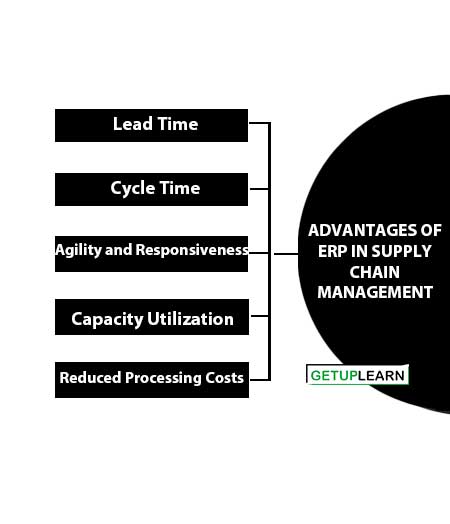Table of Contents
Advantages of ERP in Supply Chain Management
Notwithstanding the type of supply chain and the products therein, a transparent flow of information across the board is essential. The accurate information flow provides agility in the chain making it responsive to the variations in the market. The advantages of ERP implementation in the supply chain are delineated below.

Lead Time
ERP systems integrate sales and distribution modules with manufacturing. No sooner orders are received at the end of the sale, a set of activities are triggered by virtue of the same. The finished goods inventory status is checked to fulfill the orders received which is found unavailable triggers actions for manufacturing of the same.
The requirement of demand is percolated to the suppliers who in turn are informed of the need for material supply at the production point. Consequently, purchase orders are issued to the suppliers and payments follow accordingly.
Cycle Time
Prior to ERP system implementation, orders received had to progress through various stages within the supply chain from the retailer, distributor, assembler, manufacturer, etc. The flow of the information of orders received moved in phases from one stage to the other. At each stage order quantity and variety are received from the preceding stage with inputs from the previous stage.
Many a time figures were inflated in anticipation of further variations in the customer levels. The stage-wise flow itself was an elongated process. Decisions were triggered at each stage through order status received from the preceding stages adding to elongated cycle times. As a result of ERP ease in the flow of real-time accurate order information, reduced cycle time to as much as 5%.
Agility and Responsiveness
Real-time access to demand data facilitates in streamlining the production plan and integrates with suppliers to adhere to lead time while providing the right product at the right time and variety. Configure to order, mass customization is possible only because of preponing customer order points and sharing the demand details with the OEMs and suppliers.
Capacity Utilization
Real-time demand data access provides adequate aid in capacity planning on the shop floor. Decisions on subcontracting and overtime can be initiated without delays since forecast data and actual demand data are available. This ensures customer goodwill and loss due to the underutilization of capacity.
Reduced Processing Costs
ERP implementation in the supply chain integrates partners along the chain with information. The integration reduces the costs of processing at each stage of the chain. Transaction costs are reduced making the process of information flow fast, easy, and simple.
Evolution of ERP
ERP is an abbreviation for Enterprise Resource Planning. As evident in the name, it is a concept wherein resources within an organization are integrated to achieve effective utilization for improved business performance.
The process requires integration of all the functional divisions and business processes from the stage of customer interface to the stage of sourcing resources at the production stage.
Primarily ERP integrates all the stages, and functional divisions through the availability of information in real-time across the organization. ERP packages were initially based on Manufacturing Resource Planning (MRP) concepts as the need evolved from the latter.
Planning for resources at the manufacturing level necessitated balancing resource and capacity planning with the demand data, actual orders, order status, etc. Inaccurate data on the production floor introduced a mismatch of production with demand requirements leading to high inventories, nonalignment of order delivery schedules, obsolescence, etc.
Till 1970 techniques were used for aggregate planning strategies, eventually by 1980 the focus shifted to Manufacturing Resource Planning (MRP II). MRP II supports all business operations within the organization moving ahead of raw material planning at the shop floor level. An enterprise-wide integration has been initiated through the integration of engineering, sales and distribution, finance, etc.
ERP is instrumental in improving business performance through a flexible market through the facilitation of integrated real-time decision support. ERP systems provide better analysis of data from a variety of sources and enable comprehensive decision-making.
FAQs About the Advantages of ERP
What are the advantages of ERP?
The advantages of ERP in supply chain management are: 1. Lead Time 2. Cycle Time 3. Agility and Responsiveness 4. Capacity Utilization 5. Reduced Processing Costs.
